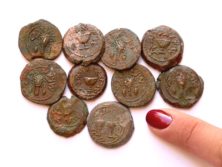The last time that the Temple stood in Jerusalem, Jewish revolutionaries were holding out against Rome in a brutal siege, minting their own coins in independent defiance. Those coins included the inscriptions of “For the Freedom of Zion” or “For the Redemption of Zion”, highlighting their struggle. Nearly two thousand years later, some of those coins were discovered near the Temple Mount by Hebrew University archaeologist Dr. Eilat Mazar. And it’s not just the history that’s eye-catching; the time of year for the discovery caught Dr. Mazar’s attention as well.
“A discovery like this—ancient coins bearing the words ‘Freedom’ and ‘Redemption’—found right before the Jewish Festival of Freedom—Passover—begins is incredibly moving,” Dr. Mazar was quoted by Monday’s Hebrew University press release as saying. The Festival of Passover—marking the Israeli redemption from Egyptian slavery as found in the Biblical book of Exodus—begins this year on Friday evening.
National history isn’t the only inspiring element for Dr. Mazar, but a personal connection as well. Her grandfather also found Jewish revolution coins in the area around the Temple Mount following the Israeli victory in the Six-Day War in 1967.
The majority of the coinage found by the younger Mazar come from the final year of the first Israeli revolt against Rome (69-70 of Common Era), when the inscription changed from Freedom to Redemption. The Hebrew University press release noted that the change of slogans reflected the dire straits faced by the Jewish revolutionaries in the Roman siege of Jerusalem.
However, the coins still reflected elements that made the country famous: the four Biblical plant species: palm, myrtle, citron and willow, as well as the image of the goblet used in the Temple service.
The coins were discovered in a cave, which Dr. Mazar notes was not discovered by later dwellers in Jerusalem or after the Second Temple period, leaving the coins and the rest of the artifacts in the cave well-preserved. As a result, Dr. Mazar views the cave, per the press release, as acting as a “veritable time capsule of life in Jerusalem under the siege and during the four-year revolt against the Roman Empire.”
And nearly two thousand-years later, a truly independent Israel with Jerusalem as its capital is rediscovering the coins claiming freedom and redemption—just ahead of Passover.
(By Joshua Spurlock, www.themideastupdate.com, March 26, 2018)

